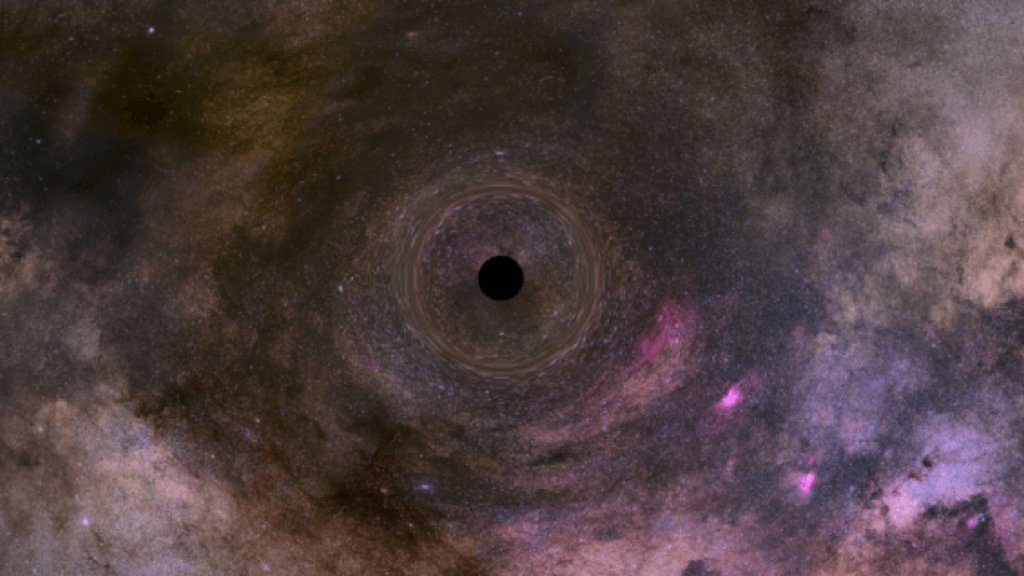
Yes, there are 100 million rogue black holes wandering our galaxy (Image Credit: Mashable)
But they are fantastically weird, gravitationally powerful places. And astronomers suspect there are some 100 million of these objects — realms so dense that not even light can escape their grasp — wandering our Milky Way galaxy. Now, for the first time, scientists published compelling evidence that they detected one of these rapidly moving, rogue black holes.
This type of black hole is created when a star (around 20 times as massive as the sun) explodes and collapses into an intensely compact object. It’s the natural evolution of things in our universe.
“These are just wandering stars. Those wandering stars become wandering black holes,” Kailash Sahu, an astronomer at the Space Telescope Science Institute who led one of the studies about this detection, told Mashable.
The reality that around 100 million of these black holes are traveling through the galaxy might seem wild. But it makes good sense. Stars die. And there are bounties of stars out there. “It sounds like a lot, but on the other hand, our galaxy has 100 billion stars,” Sahu noted. (There are other dramatic ways for black holes to form, but the collapse of stars is common.)
“The Milky Way should be full of black holes,” agreed Fabio Pacucci, an astrophysicist at the Center for Astrophysics – Harvard & Smithsonian who had no role in the new research.
“The Milky Way should be full of black holes.”
Crucially, there might be a profound number of black holes in our galaxy, but they’re still relatively far from our solar system — because space, like our galaxy, is vast. This rogue black hole is some 5,000 light-years away (one light-year is nearly 6 trillion miles). Statistically, the closest rogue black hole should be some 80 light-years away, the researchers say. For perspective, the closest star, Proxima Centauri, is four light-years (or some 24 trillion miles) away from us.
While these nomadic black holes are wandering the galaxy, it’s important to remember that we are, too. Our solar system is moving around the center of the Milky Way (home to a supermassive black hole called Sagittarius A*) at over 500,000 mph (828,000 km/h).
“Everything is kind of wandering – nothing is really stationary,” said Sahu.
However, these rogue black holes, after being created during extreme, catastrophic explosions, have certainly been given a good kick that sends them on a more random path through the galaxy. A nomadic black hole could potentially disrupt the orbits of planets in a solar system if it happened to pass close by. But black holes aren’t sucking up everything in the cosmos. “They are not vacuum cleaners, otherwise we’d be in one,” Douglas Gobeille, an astrophysicist and black hole researcher at the University of Rhode Island, told Mashable earlier this year.
The rogue black hole detection
Black holes don’t emit any light. How can astronomers see the unseeable?
To make this observation over several years, the astronomers did something clever. Black holes, extremely dense objects, warp space, like a bowling ball sitting on a mattress. Using the school bus-sized Hubble Space Telescope, the research team diligently watched for an extremely dense object (like a black hole) to pass in front of a distant star. The passing black hole’s presence warped and bent the starlight as it bisected this region of space, allowing for a type of observation called “microlensing.”
What’s more, the Hubble telescope then measured how much light the black hole deflected, which required observing minute changes in light. Hubble is an exquisite instrument for making this sensitive observation because it orbits above Earth, so its views aren’t blurred and distorted by our atmosphere.

Credit: NASA / ESA / STScI / Joseph Olmsted
Taken together, observations of warped and deflected light gave astronomers the information they needed to judge the black hole’s mass, distance, and beyond. “It’s almost like putting the black hole on a scale,” Sahu explained. They found this lone black hole wanderer is seven times the mass of the sun. (Some 30 percent of wandering black holes are believed to travel alone; others have companions.)
“This is a very remarkable detection,” the astrophysicist Pacucci told Mashable.
“This is a very remarkable detection.”
One issue, however, remains unresolved. There is still a possibility that what has been detected is another immensely dense object that can warp space, like a neutron star, which is the collapsed core of an exploded star. (Neutron stars are so dense, a “sugar-cube-sized amount of material would weigh more than 1 billion tons, about the same as Mount Everest!” NASA explains.) Another group of researchers found the object was smaller, at some 1.6 and 4.4 times the mass of the sun. An object some 1.6 times the size of the sun would more likely be a neutron star.
But, even so, there’s one more crucial piece of evidence suggesting the detected object is indeed a black hole. The object in question did not temporarily alter the light color of the background star. If it was a neutron star, the two light sources would have mixed. But there was no color change.
It remains enormously difficult to detect these roaming black holes, moving at some 100,000 mph. But in the future, advanced space telescopes, like NASA’s Roman Space Telescope, are expected to spot many more of these curious objects in the deep, deep cosmos.





